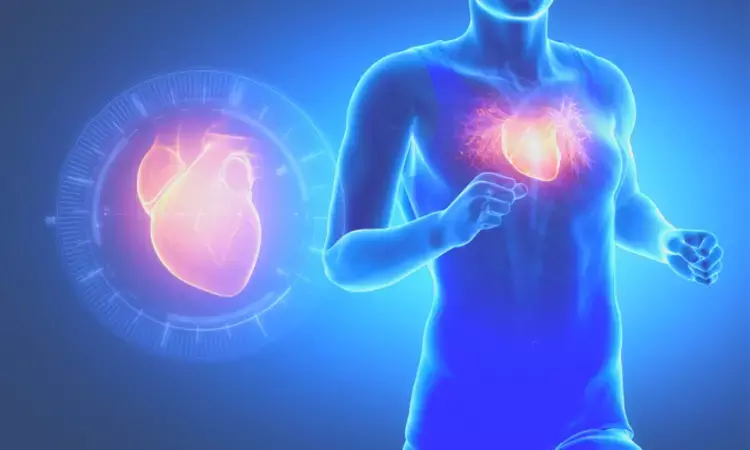- Home
- Medical news & Guidelines
- Anesthesiology
- Cardiology and CTVS
- Critical Care
- Dentistry
- Dermatology
- Diabetes and Endocrinology
- ENT
- Gastroenterology
- Medicine
- Nephrology
- Neurology
- Obstretics-Gynaecology
- Oncology
- Ophthalmology
- Orthopaedics
- Pediatrics-Neonatology
- Psychiatry
- Pulmonology
- Radiology
- Surgery
- Urology
- Laboratory Medicine
- Diet
- Nursing
- Paramedical
- Physiotherapy
- Health news
- Fact Check
- Bone Health Fact Check
- Brain Health Fact Check
- Cancer Related Fact Check
- Child Care Fact Check
- Dental and oral health fact check
- Diabetes and metabolic health fact check
- Diet and Nutrition Fact Check
- Eye and ENT Care Fact Check
- Fitness fact check
- Gut health fact check
- Heart health fact check
- Kidney health fact check
- Medical education fact check
- Men's health fact check
- Respiratory fact check
- Skin and hair care fact check
- Vaccine and Immunization fact check
- Women's health fact check
- AYUSH
- State News
- Andaman and Nicobar Islands
- Andhra Pradesh
- Arunachal Pradesh
- Assam
- Bihar
- Chandigarh
- Chattisgarh
- Dadra and Nagar Haveli
- Daman and Diu
- Delhi
- Goa
- Gujarat
- Haryana
- Himachal Pradesh
- Jammu & Kashmir
- Jharkhand
- Karnataka
- Kerala
- Ladakh
- Lakshadweep
- Madhya Pradesh
- Maharashtra
- Manipur
- Meghalaya
- Mizoram
- Nagaland
- Odisha
- Puducherry
- Punjab
- Rajasthan
- Sikkim
- Tamil Nadu
- Telangana
- Tripura
- Uttar Pradesh
- Uttrakhand
- West Bengal
- Medical Education
- Industry
Vigorous walking exercise critical for rehabilitation among stroke patients: JAMA

USA: The findings from a multicenter randomized clinical trial published in JAMA Neurology showed that vigorous training intensity is a crucial dosing parameter for locomotor exercise in patients with chronic stroke.
The study showed that vigorous walking exercise produced meaningful gains in walking capacity with only four weeks of training. Still, at least 12 weeks were needed to maximize immediate gains in patients with chronic stroke.
Most stroke survivors eventually regain their walking ability without physical help from another person; however, most in the recovery's chronic phase still lack sufficient walking capacity (i.e., endurance and speed) to get back to their normal daily activities. Aerobic deconditioning and neuromotor impairment underlying these limitations in walking capacity can be targeted along with locomotor exercise (i.e., task-specific walking practice at sufficient intensity to challenge the cardiopulmonary and neuromotor systems).
With this intervention, training intensity is a critical dosing parameter linked with outcomes. However, the optimal intensity for improving walking recovery has yet to be discovered. To fill this knowledge gap, Pierce Boyne from the University of Cincinnati in Cincinnati, Ohio, and colleagues aimed to assess the optimal training intensity (moderate versus vigorous) and minimum training duration (12, 8, or 4 weeks) required to maximize immediate improvement in walking capacity in chronic stroke patients in a multicenter randomized clinical trial using an intent-to-treat analysis.
The trial was conducted from January 2019 to April 2022 at exercise research and rehabilitation laboratories. It included survivors of a single stroke (aged 40 to 80 years) having persistent walking limitations for six months or above following the stroke.
Patients were randomized in a ratio of 1:1 to HIIT (high intensity interval training) or MAT (moderate-intensity aerobic exercise). Each protocol involved 45 minutes of walking practice thrice weekly for 12 weeks. In the HIIT protocol, repeated 30-second bursts of walking at maximum safe speed were used, alternated with 30- to 60-second rest periods, targeting a mean aerobic intensity above 60% of the HRR (heart rate reserve). In the MAT protocol, continuous walking was used with speed adjusted to maintain an initial target of 40% of the HRR, progressing to 60% of the HRR with tolerance.
The study's primary outcome was a 6-minute walk test distance. After 4, 8, and 12 weeks of training, outcomes were evaluated by blinded raters.
The study led to the following findings:
- Of 55 participants (mean age, 63 years; 65.5% males), 27 were randomized to HIIT and 28 to MAT. The mean time since stroke was 2.5 years, and the mean 6-minute walk test distance at baseline was 239 m.
- Participants attended 1675 of 1980 planned treatment visits (84.6%) and 197 of 220 planned testing visits (89.5%).
- No serious adverse events related to study procedures occurred.
- Groups had similar 6-minute walk test distance changes after four weeks (HIIT, 27 m; MAT, 12 m; mean difference, 15 m), but HIIT elicited more significant gains after eight weeks (58 m vs 29 m; mean difference, 29 m) and 12 weeks (71 m vs 27 m; mean difference, 44 m) of training; HIIT also showed greater improvements than MAT on some secondary measures of gait speed and fatigue.
To conclude, optimal dosing for walking exercise in chronic stroke patients may include at least 12 weeks of training at vigorous intensity.
In the trial involving locomotor exercise among stroke survivors with chronic walking limitations, "vigorous training intensity was better than moderate intensity for causing immediate improvements in walking capacity and other outcomes," the researchers wrote. "With this vigorous-intensity locomotor exercise, 12 weeks of training produced greater gains than shorter durations."
Reference:
Boyne P, Billinger SA, Reisman DS, et al. Optimal Intensity and Duration of Walking Rehabilitation in Patients With Chronic Stroke: A Randomized Clinical Trial. JAMA Neurol. Published online February 23, 2023. doi:10.1001/jamaneurol.2023.0033
Dr Kamal Kant Kohli-MBBS, DTCD- a chest specialist with more than 30 years of practice and a flair for writing clinical articles, Dr Kamal Kant Kohli joined Medical Dialogues as a Chief Editor of Medical News. Besides writing articles, as an editor, he proofreads and verifies all the medical content published on Medical Dialogues including those coming from journals, studies,medical conferences,guidelines etc. Email: drkohli@medicaldialogues.in. Contact no. 011-43720751


